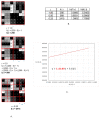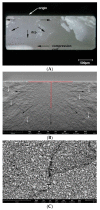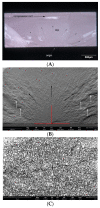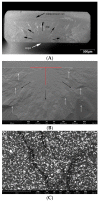Printable and Machinable Dental Restorative Composites for CAD/CAM Application-Comparison of Mechanical Properties, Fractographic, Texture and Fractal Dimension Analysis
- PMID: 34501009
- PMCID: PMC8434230
- DOI: 10.3390/ma14174919
Printable and Machinable Dental Restorative Composites for CAD/CAM Application-Comparison of Mechanical Properties, Fractographic, Texture and Fractal Dimension Analysis
Abstract
Thanks to the continuous development of light-curing resin composites it is now possible to print permanent single-tooth restorations. The purpose of this study was to compare resin composites for milling -Gandio Blocks (GR), Brilliant Crios (CR) and Enamic (EN) with resin composite for 3D printing-Varseo Smile Crown plus (VSC). Three-point bending was used to measure flexural strength (σf) and flexural modulus (Ef). The microhardness was measured using a Vickers method, while fractographic, microstructural, texture and fractal dimension (FD) analyses were performed using SEM, optical microscope and picture analysis methods. The values of σf ranged from 118.96 (±2.81) MPa for EN to 186.02 (±10.49) MPa for GR, and the values of Ef ranged from 4.37 (±0.8) GPa for VSC to 28.55 (±0.34) GPa for EN. HV01 ranged from 25.8 (±0.7) for VSC to 273.42 (±27.11) for EN. The filler content ranged from 19-24 vol. % for VSC to 70-80 vol. % for GR and EN. The observed fractures are typical for brittle materials. The correlation between FD of materials microstructure and Ef was observed. σf of the printed resin depends on layers orientation and is significantly lower than σf of GR and CR. Ef of the printed material is significantly lower than Ef of blocks for milling.
Keywords: dental CAD/CAM materials; fractal dimension analysis; fractography; printable resin composites; texture analysis.
Conflict of interest statement
The authors declare no conflict of interest. The funders had no role in the design of the study; in the collection, analyses, or interpretation of data; in the writing of the manuscript, or in the decision to publish the results.
Figures

















Similar articles
-
Comparison of mechanical and surface properties of two 3D printed composite resins for definitive restoration.J Prosthet Dent. 2024 Oct;132(4):839.e1-839.e7. doi: 10.1016/j.prosdent.2024.07.003. Epub 2024 Jul 27. J Prosthet Dent. 2024. PMID: 39069391
-
Resin Composite Materials for Chairside CAD/CAM Restorations: A Comparison of Selected Mechanical Properties.J Healthc Eng. 2021 Apr 28;2021:8828954. doi: 10.1155/2021/8828954. eCollection 2021. J Healthc Eng. 2021. PMID: 34007429 Free PMC article.
-
Printable PICN Composite Mechanically Compatible with Human Teeth.J Dent Res. 2021 Dec;100(13):1475-1481. doi: 10.1177/00220345211012930. Epub 2021 May 12. J Dent Res. 2021. PMID: 33978514
-
Mechanical Properties of 3D Printed vs. Subtractively Manufactured Composite Resins for Permanent Restorations: A Systematic Review.Materials (Basel). 2025 Feb 24;18(5):985. doi: 10.3390/ma18050985. Materials (Basel). 2025. PMID: 40077210 Free PMC article. Review.
-
Mechanical Properties of Additive-Manufactured Composite-Based Resins for Permanent Indirect Restorations: A Scoping Review.Materials (Basel). 2024 Aug 8;17(16):3951. doi: 10.3390/ma17163951. Materials (Basel). 2024. PMID: 39203129 Free PMC article.
Cited by
-
Fractal Dimension and Texture Analysis in the Assessment of Experimental Laser-Induced Periodic Surface Structures (LIPSS) Dental Implant Surface-In Vitro Study Preliminary Report.Materials (Basel). 2022 Apr 7;15(8):2713. doi: 10.3390/ma15082713. Materials (Basel). 2022. PMID: 35454406 Free PMC article.
-
Mechanical Properties, Fractal Dimension, and Texture Analysis of Selected 3D-Printed Resins Used in Dentistry That Underwent the Compression Test.Polymers (Basel). 2023 Apr 2;15(7):1772. doi: 10.3390/polym15071772. Polymers (Basel). 2023. PMID: 37050388 Free PMC article.
-
Translucency of Lithium-Based Silicate Glass-Ceramics Blocks for CAD/CAM Procedures: A Narrative Review.Materials (Basel). 2023 Sep 27;16(19):6441. doi: 10.3390/ma16196441. Materials (Basel). 2023. PMID: 37834578 Free PMC article. Review.
-
Translucency of CAD/CAM and 3D Printable Composite Materials for Permanent Dental Restorations.Polymers (Basel). 2023 Mar 15;15(6):1443. doi: 10.3390/polym15061443. Polymers (Basel). 2023. PMID: 36987234 Free PMC article.
-
Effect of thermocycling on the mechanical properties of permanent composite-based CAD-CAM restorative materials produced by additive and subtractive manufacturing techniques.BMC Oral Health. 2024 Mar 14;24(1):334. doi: 10.1186/s12903-024-04016-z. BMC Oral Health. 2024. PMID: 38486195 Free PMC article.
References
-
- Kawaguchi-Uemura A., Mine A., Matsumoto M., Tajiri Y., Higashi M., Kabetani T., Hagino R., Imai D., Minamino T., Miura J., et al. Adhesion procedure for CAD/CAM resin crown bonding: Reduction of bond strengths due to artificial saliva contamination. J. Prosthodont. Res. 2018;62:177–183. doi: 10.1016/j.jpor.2017.08.006. - DOI - PubMed
-
- Naseer M.U., Kallaste A., Asad B., Vaimann T., Rassõlkin A. A Review on Additive Manufacturing Possibilities for Electrical Machines. Energies. 2021;14:1940. doi: 10.3390/en14071940. - DOI
Grants and funding
LinkOut - more resources
Full Text Sources
Research Materials
Miscellaneous

